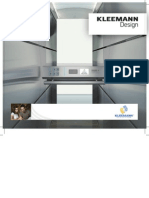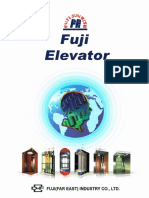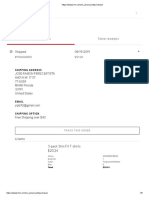Hydraulic Elevator Installation Checklist: Schindler 330A
Hydraulic Elevator Installation Checklist: Schindler 330A
Uploaded by
MMMOH200Copyright:
Available Formats
Hydraulic Elevator Installation Checklist: Schindler 330A
Hydraulic Elevator Installation Checklist: Schindler 330A
Uploaded by
MMMOH200Original Title
Copyright
Available Formats
Share this document
Did you find this document useful?
Is this content inappropriate?
Copyright:
Available Formats
Hydraulic Elevator Installation Checklist: Schindler 330A
Hydraulic Elevator Installation Checklist: Schindler 330A
Uploaded by
MMMOH200Copyright:
Available Formats
Schindler 330A ®
Hydraulic elevator installation checklist
Schindler Hydraulic Elevator System
Schindler 330A ®
Hydraulic elevator installation checklist
Delivery of equipment C3 Hoistway walls
Prior to elevator equipment delivery, an enclosed dry – Masonry: Provide opening of +8” (203 mm) on each
hoistway, a ready machine room, and temporary or side and +8” (203 mm) on top of clear opening for
permanent three-phase power must be available. installation of door frames and sills by Schindler.
– Dry wall: Walls at entrance to be built after door sills
General Contractor and frames are set in place.
– Provide adequate, rollable access for delivery and – Grout entrances and sills after installation by Schindler.
material unloading, and a dry place for storage of – No conduit, duct or piping allowed in the hoistway
equipment located near hoistway. that is not related to the elevator equipment.
– Refer to elevator layout. Please verify hoistway finished – Pit and hoistway must be dry at all times.
clear width and depth, pit depth, floor-to-floor heights, C4 – If job requires cutting and patching of walls, floors, etc.,
and clear overhead. and removal of such obstruction for proper installation
– Build a clear, plumb, legal hoistway in accordance with of the elevator as well as pockets or blockouts for
applicable code from top-to-bottom with variations not signal fixtures, it is to be done by General Contractor.
to exceed 1” (25.4 mm) per 100’ (2540 mm). Refer to elevator layout. Seal all wall penetrations with
– Provide attachment points for elevator rail brackets. material approved by code to maintain fire rating.
Locate per layout. C5 – OSHA-approved barricades must be installed with
P1 – If jackhole is required for borehole jack system, see kick board at each opening.
Detail A on reverse side. C6 – Attachment points for elevator rail bracket supports
C1 – Check local codes for ventilation requirements. Refer (inserts, steel or concrete) are needed at all floor levels
also to Ventilation Requirements on reverse side. and in overhead. Supports between floors may be
C2 – Supply hoist beam for elevator construction and necessary per code if span is excessive. Coordinate
service work. Beam to run across the width of the locations with Schindler.
elevator shaft. Loads and location per elevator layout. – Bevel all hoistway projections and recesses in accor-
Beam to be removed by General Contractor after dance with applicable codes.
elevator installation if minimum overhead cab C7 – Divider beams are required between adjacent elevators
clearances are not available. at all floor levels and at 10’ (254 mm) above top
landing. Locate per layout.
C8 – Provide drain or sump hole in pit as required by gov-
C1
erning local code. Cover for sump shall be level with
pit floor. Drains connected directly to sewers shall
Clear not be installed in elevator pits. Location to be coor-
C2 Overhead dinated with Schindler. Pit must be dry at all times.
C9 – Provide pit ladder — location per layout.
C10 – Provide 8” x 8” (203 x 203 mm) blockout for oil line
and wire duct. To be sealed by General Contractor.
C3 Location to be coordinated with Schindler. For remote
C4
C5
machine rooms, provide clear access above ceiling or
C6 coordinate with Schindler field supervisor.
Top
Landing Machine room
C7
C8 C11 – Machine room temperature must be maintained
C9
C10
between 55°F (13°C) and 90°F (32°C) for proper
operation of equipment.
C11
E1
– No conduit, duct or piping allowed in the machine
E2 Bottom room that is not related to the elevator equipment.
C12 Landing C12 – Provide fire-rated, self-closing, self-locking machine
room door, fire extinguisher (type ABC), and live
Pit
analog phone line.
P1
– All oil lines and duct runs for remote machine room
will be overhead.
Schindler 330A Checklist
2
Electrical Contractor Sound suppression
– If sprinklers are required, provide smoke sensing devices The following guidelines are to be followed to reduce
at elevator lobbies and/or at top of elevator shaft with noise to acceptable levels.
electrical conductors terminating at elevator controller 1. The surrounding walls, floor, and ceiling assembly
in machine room for automatic elevator recall system should have a substantial STC (Sound Transmission
in the event of a fire. Class) rating. The higher the STC rating, the better. If
E1 – Must immediately confirm the type of three-phase noise-sensitive areas are nearby, STC 50 or 55 should
power to the elevator equipment room (208 volt, be used as the design criteria for the surrounding
230 volt, 240 volt, 460 volt, 480 volt, 575 volt or structure. Concrete block walls will provide STC 42.
600 volt) and provide before work can begin. Refer Two layers of gypsum board on each side of 3 5/8”
to Schindler power data sheet for approval. steel studs at standard spacing (total of four layers,
– Provide a fused, heavy duty, three-phase, lockable two on each side) with fiberglass batt in the cavity
disconnect or shunt trip breaker and single-phase will provide STC 56. All cracks and gaps around the
lockable disconnect (for car lighting and fan) in perimeter must be copiously filled with the appropriate
machine room with feeder branch wiring to elevator acoustical caulking. Wood studs should be avoided,
controller. Disconnect size to suit elevator contractor’s but if they are used, attach drywall with resilient
equipment requirements. All work must be per channel or use a staggered stud arrangement.
National Electric Code and ASME A17.1 and any 2. In situations where noise-sensitive areas are not an
local codes. Locate per layout. issue, two layers of drywall (four total) are still rec-
– When the battery lowering/anti-entrapment device ommended and caulk sufficiently around the perimeter.
is required, provide a dedicated, labeled, 110V, Double-layer drywall with staggered seams works best.
15A circuit and conduit. When a heat exchanger is 3. The door must have a good STC rating. A rated door
required, provide a dedicated, labeled, 110V, 20A and frame assembly are needed if a noise-sensitive area
circuit with disconnect. Refer to the Schindler power is nearby, requiring low noise levels, such as NV 30 or
data information for additional information. 30 dBA which is not typical. Ideally an STC 55 door
– Shunt trip breaker required if sprinkler in pit, hoistway would be best to match the walls. Rated doors may
or machine room. have cam hinges that raise the door and then lower it
– Provide adequate lighting and receptacle in machine when it closes to eliminate the gap at the base and a
room. Locate per layout. tight seal around the perimeter along with sufficient
E2 – Per the latest National Electrical Code, all receptacles mass to give the door a good STC rating. Doors with a
installed in machine rooms, machinery and control lower rating (e.g., STC 40), may be adequate for non-
spaces, and pits must have Ground Fault Circuit noise-sensitive areas (e.g., NC 40-45 or 40-45 dBA),
Interrupter Protection (GFCI). at a substantially reduced cost.
– Provide a light and receptacle in elevator pit. Locate 4. If a standard door is used, good sealing hardware is
per layout. needed to seal around the perimeter of the door.
5. Penetrations through the equipment room wall must
Schindler Elevator Corporation be kept to a minimum. When pipes and conduit pass
– Supplies telephone in car and travel cable to car. through the walls, they must be sealed with mortar or
the appropriate acoustical sealant to prevent noise
Machine room design considerations
leaks. A heavy, solid material must be used. Do not
A properly designed machine room will provide additional
use fiberglass.
noise suppression for the power unit using standard
6. If the walls are concrete block, do not paint them.
construction material. When possible, locate the power
Unpainted block has about 33% absorption, which
unit away from noise-sensitive areas.
is lost with a coat of paint. Fiberglass panels on the
ceiling or walls covering 25% of the area are benefi-
cial, but not mandatory.
All wiring (including analog phone line) to machine room supplied
by owner.
Local codes may vary. Consult with your architect/ engineer and
local Schindler representative.
Schindler 330A Checklist
3
Schindler 330A ®
Hydraulic elevator installation checklist
7. Vibration isolation of the unit normally will not be Borehole applications only
needed when the unit is attached to a concrete Jack hole drilling — Schindler must have clear access
foundation. If used on an upper floor, 2” deflection for truck-mounted drill rig (unless inside drilling is
springs properly sized and installed are suggested. If required in an existing building). Contractor to locate
used on wooden floors, springs are mandatory. the jack hole for the driller and remove jack hole spoils
8. The pipe from the power unit to the hoistway after drilling is complete. (See Detail A below.)
should be “vibrationally” isolated from the wall and
Detail A
the perimeter of the pipe sealed with the appropri- Jack Hole
ate acoustical sealant to prevent acoustical leaks or
flanking paths for vibration noise. ”A”
Jack Hole
Rear
Ventilation requirements
The following guidelines are to be followed to maintain
acceptable elevator equipment room temperatures:
1. Machine room temperature must be maintained
Front
between 55° and 90° F. ”A”
Hoistyway Plan
2. A vented door should be avoided. Air removal
should be done by ducting the air from the room to
the outside if possible. A forced removal of the air to Bottom Car
Landing Travel
another part of the building or building exterior is Jack Hole
”A” Pit Depth
needed to keep an air exchange through the equip-
ment room. Intake and exhaust vents should not be
located next to each other. This arrangement is high-
Pit Floor
ly advantageous since it also keeps the room cooler
”C”
(e.g., 70° F), which benefits the operation of the
”B” Hole Depth
power unit and reduces the likelihood of overheating.
A+B=C
3. Minimum machine room ventilation requirements for
hydraulic elevators:
Rated HP BTU/hr CFM* ”B” Hole Depth = Travel + 6’ 6” – Pit Depth
15 3740 190 Section Thru — ”A-A”
20 4740 240
25 5740 290
30 6740 350
40 8740 450
50 10740 550
* Minimum air at 70° F to be moved in and out of the machine room.
© Schindler Elevator Corporation 2007
For further information including location of
the Schindler office nearest you, please visit:
A0710
www.us.schindler.com
North American Headquarters
CMN-1004
Morristown, New Jersey 07962-1935
Tel. 973.397.6500
You might also like
- Kinetek Elevator CatalogueDocument28 pagesKinetek Elevator CatalogueNasco TradingNo ratings yet
- Experiment 7 - Salivary Amylase PH and TemperatureDocument5 pagesExperiment 7 - Salivary Amylase PH and Temperatureshr sem0% (1)
- Subsea Wellhead SystemDocument61 pagesSubsea Wellhead Systemdericlock100% (5)
- Synergy Element Brochure LowDocument16 pagesSynergy Element Brochure Lowangela1590No ratings yet
- Schindler R300: High Performance Roller Guide ShoeDocument2 pagesSchindler R300: High Performance Roller Guide ShoeWashington MazziniNo ratings yet
- 14240FL ThyssenKruppDocument21 pages14240FL ThyssenKruppManish Singh50% (2)
- Synergy Element BrochureDocument12 pagesSynergy Element Brochureangela1590No ratings yet
- Elevator Class SlidesDocument16 pagesElevator Class Slidesapi-312462673No ratings yet
- Schindler Vs OtisDocument1 pageSchindler Vs OtisMark Goduco0% (1)
- Pulley On Removal Procedure CarDocument9 pagesPulley On Removal Procedure CarSupri AdiNo ratings yet
- ARES Escalator 6Document7 pagesARES Escalator 6GutmonarchNo ratings yet
- Technical Specification (LG Rise) : ControlDocument6 pagesTechnical Specification (LG Rise) : ControlAntr HasanNo ratings yet
- ElevatorDocument21 pagesElevatormmzzzNo ratings yet
- Elevator Installation Manual PDF - Google SearchDocument2 pagesElevator Installation Manual PDF - Google SearchP MuralidharanNo ratings yet
- Escalator Step Installation and Maintenance: Course 210Document12 pagesEscalator Step Installation and Maintenance: Course 210Camcad CncNo ratings yet
- Architect's and Consultant's Specification Guide: Otis Elevator CompanyDocument12 pagesArchitect's and Consultant's Specification Guide: Otis Elevator CompanyjamesNo ratings yet
- Traction Drive Elevator Without Machine Room With Variable Car Dimensions. Rated Load 630 - 1050 KGDocument8 pagesTraction Drive Elevator Without Machine Room With Variable Car Dimensions. Rated Load 630 - 1050 KGTúlio ParreirasNo ratings yet
- 05sml9039-Inform-Sheet-En 5300 Schindler PDFDocument8 pages05sml9039-Inform-Sheet-En 5300 Schindler PDFRodrigo AntonioNo ratings yet
- Technology On The Move.: The W 191 Drive SystemDocument2 pagesTechnology On The Move.: The W 191 Drive Systemangela1590No ratings yet
- Otis Pulse FCTSH 040805Document25 pagesOtis Pulse FCTSH 040805angela1590100% (2)
- Schindler Ahead: Smart Urban MobilityDocument8 pagesSchindler Ahead: Smart Urban MobilityMileNo ratings yet
- Vfi Ii - Hees 007 (1) 0110Document19 pagesVfi Ii - Hees 007 (1) 0110dep_vin100% (1)
- Solon Standard EnglishDocument30 pagesSolon Standard EnglishPuri PurwantariNo ratings yet
- Otis Fact Sheet 2010Document10 pagesOtis Fact Sheet 2010nrolandy100% (1)
- Endura MRL: Low-Rise ElevatorDocument24 pagesEndura MRL: Low-Rise ElevatorMohd Abu Ajaj100% (1)
- EN Synergy Jan 2015 PDFDocument10 pagesEN Synergy Jan 2015 PDFanh trongNo ratings yet
- TysenDocument96 pagesTysenMahmoud SanadNo ratings yet
- TK-50 Installation Manual Rev 1.1 - EVO1Document20 pagesTK-50 Installation Manual Rev 1.1 - EVO1anh trong0% (1)
- Escalator BasicsDocument32 pagesEscalator BasicsIan FlanneryNo ratings yet
- KLEEMANN Design - New Catalog For Lift Cabins, Cops-Lops and DoorsDocument77 pagesKLEEMANN Design - New Catalog For Lift Cabins, Cops-Lops and DoorsKleemmann Hellas SANo ratings yet
- FIN Escalator 2022Document32 pagesFIN Escalator 2022MARICAR SIGUE100% (1)
- SynergyDocument16 pagesSynergymalesevac0% (1)
- XJ Schindler Passazhirskiy LiftDocument32 pagesXJ Schindler Passazhirskiy Liftkonsuba teknik perkasa100% (1)
- Schindler 330a Hydraulic Elevator BrochureDocument20 pagesSchindler 330a Hydraulic Elevator BrochureDjoNo ratings yet
- Motion Detectors For ElevatorsDocument20 pagesMotion Detectors For ElevatorsFERNSNo ratings yet
- Error 94 Schindler Hydra 330aDocument3 pagesError 94 Schindler Hydra 330aIJGUNo ratings yet
- Installation Manual Omega 2016 - Version04!10!16Document49 pagesInstallation Manual Omega 2016 - Version04!10!16Diego Félix Esparza DiantaNo ratings yet
- EN81-28 Pocket Guide ENDocument20 pagesEN81-28 Pocket Guide ENfran100% (1)
- Escalators Jagannath University: Submitted By: Akash Kumar Sem-Vii, Sec-A Submitted To: Ar. Gaurav AgrawalDocument29 pagesEscalators Jagannath University: Submitted By: Akash Kumar Sem-Vii, Sec-A Submitted To: Ar. Gaurav Agrawalnaman sharmaNo ratings yet
- 7502.9041 MANUAL ES 5000 Escalator PDFDocument48 pages7502.9041 MANUAL ES 5000 Escalator PDFMohammed ansarNo ratings yet
- AscensoresDocument12 pagesAscensoresOvidio ReyesNo ratings yet
- Guide Specifications For NCE Escalator by Otis Elevator CoDocument7 pagesGuide Specifications For NCE Escalator by Otis Elevator Comulai119No ratings yet
- MRL Installation Manual AdditionalDocument17 pagesMRL Installation Manual AdditionalJean Luis SaviñónNo ratings yet
- Fuji SunriseDocument23 pagesFuji SunriseEdwin Ramos Policarpio100% (1)
- Gen2 CNDocument17 pagesGen2 CNMohammad Sami67% (3)
- Eco 2i Traction MRL enDocument17 pagesEco 2i Traction MRL enhabibullaNo ratings yet
- Tkaw-Manual-Ba Atr tw63 2018 09-EnDocument106 pagesTkaw-Manual-Ba Atr tw63 2018 09-EnIssa AwadallahNo ratings yet
- PM 7 000338 en 01Document30 pagesPM 7 000338 en 01Anonymous N57sCcpiNo ratings yet
- KONE ElevatorDocument6 pagesKONE Elevatorarky.globalintiNo ratings yet
- Sigma MRL E1000 PDFDocument8 pagesSigma MRL E1000 PDFMitroNo ratings yet
- ARES Escalator 5Document3 pagesARES Escalator 5GutmonarchNo ratings yet
- Di B'rite Elevator: Installation ManualDocument26 pagesDi B'rite Elevator: Installation ManualIshtiaq HussainNo ratings yet
- VIEW User V4 Manual - THYSSEN PDFDocument70 pagesVIEW User V4 Manual - THYSSEN PDFsmsobhanNo ratings yet
- 14 21 23 MRL Electric Traction Passenger Elevators (Schindler Elevator Corporation)Document12 pages14 21 23 MRL Electric Traction Passenger Elevators (Schindler Elevator Corporation)Bahaa RaslanNo ratings yet
- DIY Quick Reference Guide - 3300Document5 pagesDIY Quick Reference Guide - 3300allbsforakNo ratings yet
- Analogue Speed Sensor Q264127 EngDocument5 pagesAnalogue Speed Sensor Q264127 EngPio RodolfoNo ratings yet
- Brake Board ManualDocument17 pagesBrake Board ManualMohamedElsawiNo ratings yet
- Endura MRL - Elevator Submittal (From Other Project)Document7 pagesEndura MRL - Elevator Submittal (From Other Project)saurabh bansal100% (1)
- User Manual Installation BOM Extraction For Elevators - DraftDocument10 pagesUser Manual Installation BOM Extraction For Elevators - DraftsudhakpNo ratings yet
- Elevator Systems of the Eiffel Tower, 1889From EverandElevator Systems of the Eiffel Tower, 1889Rating: 3 out of 5 stars3/5 (1)
- 07 Primary Secondary PumpingDocument63 pages07 Primary Secondary PumpingMMMOH200No ratings yet
- CR MOD 17 Heating and Cooling09Document36 pagesCR MOD 17 Heating and Cooling09MMMOH200No ratings yet
- U W Mechanical Plumbing: Facilities Services Design Guide Compressed Air, Vacuum, Natural Gas, & NitrogenDocument3 pagesU W Mechanical Plumbing: Facilities Services Design Guide Compressed Air, Vacuum, Natural Gas, & NitrogenMMMOH200No ratings yet
- CR Program Manual and Application With RollbackDocument38 pagesCR Program Manual and Application With RollbackMMMOH200No ratings yet
- National Association of The Remodeling Industry: Standards of Practice Manual and Code of EthicsDocument17 pagesNational Association of The Remodeling Industry: Standards of Practice Manual and Code of EthicsMMMOH200No ratings yet
- 08 Variable Volume DistributionDocument35 pages08 Variable Volume DistributionMMMOH200No ratings yet
- 5 Pipe Loops Versus Compression: 2785 - C005.fm Page 177 Friday, April 1, 2005 3:30 PMDocument24 pages5 Pipe Loops Versus Compression: 2785 - C005.fm Page 177 Friday, April 1, 2005 3:30 PMMMMOH200No ratings yet
- For Hydraulic and Traction Elevators: Schindler CeilingsDocument4 pagesFor Hydraulic and Traction Elevators: Schindler CeilingsMMMOH200No ratings yet
- Elevator Catalogue: Brushes, Springs, and HoldersDocument26 pagesElevator Catalogue: Brushes, Springs, and HoldersMMMOH200No ratings yet
- Division 14Document6 pagesDivision 14MMMOH200No ratings yet
- Collection System Design Plans: Appendix EDocument70 pagesCollection System Design Plans: Appendix EMMMOH200No ratings yet
- HOSIPTAL LightDocument21 pagesHOSIPTAL LightMMMOH200No ratings yet
- Dry Back Vs Wetback & Related FeaturesDocument8 pagesDry Back Vs Wetback & Related FeaturesMMMOH200No ratings yet
- Missouri Division of Fire Safety Elevator Safety UnitDocument4 pagesMissouri Division of Fire Safety Elevator Safety UnitMMMOH200No ratings yet
- Voice Alarm DesignDocument3 pagesVoice Alarm DesignMMMOH200No ratings yet
- 2000 Standard For Absorption Water Chilling and Water Heating PackagesDocument25 pages2000 Standard For Absorption Water Chilling and Water Heating PackagesMMMOH200No ratings yet
- LabomDocument4 pagesLabomvyaschiromNo ratings yet
- Entrepreneurship Management: - Prof. J.C. SabooDocument51 pagesEntrepreneurship Management: - Prof. J.C. Sabookiran k.sNo ratings yet
- Experiment No. 6: Department of Mechanical Engineering MKSSS's Cummins College of Engineering For WomenDocument7 pagesExperiment No. 6: Department of Mechanical Engineering MKSSS's Cummins College of Engineering For WomenSafeer MNo ratings yet
- Supply Chain Management: Demand ForecastingDocument37 pagesSupply Chain Management: Demand Forecastingzubair_ahmed_importsNo ratings yet
- Buiding Maintenance and ManagementDocument67 pagesBuiding Maintenance and ManagementBashir IdrisNo ratings yet
- Batch Profile - 2017Document57 pagesBatch Profile - 2017Praneet TNo ratings yet
- Limit and Limit and Continuity Preparation Tips For IIT JEE - askIITiansContinuityDocument8 pagesLimit and Limit and Continuity Preparation Tips For IIT JEE - askIITiansContinuityaskiitianNo ratings yet
- Being and Becoming A Transformational LeaderDocument28 pagesBeing and Becoming A Transformational LeaderKrasne MladyNo ratings yet
- Report 2 Rolling Stock - MOUD INDIADocument160 pagesReport 2 Rolling Stock - MOUD INDIADeepak GadkariNo ratings yet
- Modicon Quantum - Change Configuration On The FlyDocument122 pagesModicon Quantum - Change Configuration On The Flyqcfwbsfrh6No ratings yet
- OG5000™ Ozone Generator Model OG5000B-A: User ManualDocument25 pagesOG5000™ Ozone Generator Model OG5000B-A: User ManualBk VinNo ratings yet
- SF-2100C ENGLISH HANDBOOK (20141209) - 副本 - nuevoDocument67 pagesSF-2100C ENGLISH HANDBOOK (20141209) - 副本 - nuevoferprissNo ratings yet
- Harry HarlowDocument7 pagesHarry HarlownykeriaNo ratings yet
- Cephalometric Analysis Manual Tracing of A LateralDocument5 pagesCephalometric Analysis Manual Tracing of A LateralMaple LauNo ratings yet
- Thesis Statement For AgeingDocument6 pagesThesis Statement For Ageingmariapolitepalmdale100% (1)
- An Introduction To Gage R&RDocument4 pagesAn Introduction To Gage R&RShiguo LiuNo ratings yet
- Eaton 216376 M22 K10 en - GBDocument6 pagesEaton 216376 M22 K10 en - GBEmmanuel Astaroth PaizaNo ratings yet
- Introduction To Development EconomicsDocument31 pagesIntroduction To Development EconomicsI Outdoor GuideNo ratings yet
- WINSEM2017-18 CSE4003 ETH SJT501 VL2017185003777 Reference Material I Digital Signature TechniquesDocument23 pagesWINSEM2017-18 CSE4003 ETH SJT501 VL2017185003777 Reference Material I Digital Signature Techniquesanon_687421514No ratings yet
- HMDocument5 pagesHMJosé Ramón Perez BatistaNo ratings yet
- SR# Call Type A-Party B-Party Date & Time Duration Cell ID ImeiDocument12 pagesSR# Call Type A-Party B-Party Date & Time Duration Cell ID ImeiSaifullah BalochNo ratings yet
- TOTAL QUALITY MANAGEMENT - Principles and Strategies - , MarkDocument60 pagesTOTAL QUALITY MANAGEMENT - Principles and Strategies - , MarkMark Anthony Casas LatNo ratings yet
- CE Objective Paper II 2010Document20 pagesCE Objective Paper II 2010Rahul SainiNo ratings yet
- Making Use of Bilingual Interview Data - Some Experiences From TheDocument13 pagesMaking Use of Bilingual Interview Data - Some Experiences From Themuhammad7abubakar7raNo ratings yet
- 429 Wind Actions Design GuideDocument12 pages429 Wind Actions Design Guidedavidpchacko100% (1)
- Worksheet - 3 Error, Approximation, MonotonicityDocument8 pagesWorksheet - 3 Error, Approximation, MonotonicityPrajjwal DwivediNo ratings yet
- Cables For EE342 CourseDocument7 pagesCables For EE342 Coursemahmab70No ratings yet
- Emergency Escape Breathing Device-Questions & AnswersDocument2 pagesEmergency Escape Breathing Device-Questions & AnswersSilvio RodriguezNo ratings yet









































































































